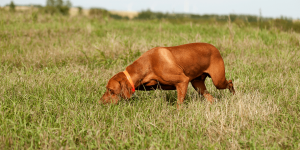How Well Can Dogs Smell? – Amazing Facts About Your Dog’s Nose.
This Holidays4Dogs article will discover some incredible facts about how well dogs can smell. You may wonder how interesting a dog’s nose could be – surely they are just pretty good at sniffing out treats? However, there are some surprising feats a dog can achieve with his nose and some are truly astounding. Read on to find out more.
Compared to a human’s six million olfactory receptors, a dog has a whopping 300 million. In addition, the part of a dog’s brain that is responsible for processing these smells is about forty times greater than a person. It is little wonder then, that while humans generally interpret the world primarily through sight, a dog understands the world around him, by taking information from things he  smells.
smells.
Pheromones.
Dogs don’t just smell basic scents like food cooking – they both produce and detect pheromones by smell. This is one of the main ways dogs communicate with one another. The pheromones that each dog gives off, is capable of producing all sorts of behaviour responses by other canines.
What’s more, some of these pheromones can be detected by dogs over long distances. They are picked up by the vomeronasal organ, or Jacobson’s organ, located in the roof of the dog’s mouth.
This is often put to use when the male dog detects pheromones from a female dog in heat. You may have notice, if you live with a male dog, he will chatter his teeth together as he processes the odour.
Because the dog’s sense of smell is so strong, they can be sensitive to certain odours such as smoke and perfumes and can find them overwhelming and uncomfortable.
Twitching noses.
When your dog sniffs the air, you will see him wiggling his nose. This is another thing that humans cannot do – wiggle their nostrils independently. Remarkably, When a dog breathes in, he is able to tell which nostril the scent arrived. As he breathes out, air is blown threw the slits at the side of his nostril so that he is able to analyse the odour.
What a dogs nose knows – what sort of scents can dogs smell?
It has long been known that dogs are capable of remarkable feats of scent tracking. This might entail looking for lost people, or criminals, often in unfamiliar environments. Dogs are highly skilled at following a trail of minute particles.
In addition, they use scent emitted from the earth and from vegetation which is crushed when a person walks over it. They can also air-scent smelling odours that are drift in the air. They also have an incredible ability to detect where the scent is most concentrated. 
The dog’s sense of smell is so acute that studies have shown they can detect early stages of cancer, including prostate and skin cancer, They do this with remarkable results and, earlier this year, the charity Medical Detection Dogs, began trials to establish whether dogs could detect breast cancer equally successfully.
Medical Detection Dogs already train assistance dogs to help people with life threatening health conditions, such as diabetes.
There are numerous other ways in which a dog can use his nose to assist humans, from drug and bomb detection dogs, to arson and human remains specialist detection dogs.
The remarkable skills of these dogs expands the idea of what a ‘working dog’ can be and how they can evolve alongside humans – from working sheepdog to bio-medical detection dog – their skill set is pretty impressive.
Nose prints.
In the same way that people can be identified by their unique finger prints, so too can dogs – but by their nose prints. The surface of a dog’s nose is made of lines and creases, just like the indentations on a fingerprint. Incredibly, the Canadian Kennel Club has been accepting nose prints as proof of a dog’s identity since 1938.
There are even many small art and craft companies using dog nose prints to produce unique gifts in the form of cards, jewellery and key rings.
Dogs with the best sense of smell.
Top of the list is the Bloodhound who has more scent receptors than any other breed. They are experts at following both ground scent, (where those large dangly ears ‘funnel’ the scent upwards) and air scent. The loose skin around the head and neck, helps to trap scent particles and retain the odour.
The Basset hound also has impressive scenting abilities. Being low to the ground, he is an ideal candidate for tracking. The Beagle and the German Shepherd are high up on the list of some of the best scenting dogs. English Springer Spaniels are another skilful scenting breed. Because of their drive and also their handy size, they are frequently the choice of breed as narcotic, or explosive detection dogs.
How well can dogs smell? – try some scent games to find out!
Dogs just love using their noses. It’s a great way for them to stimulate their brains as well as their bodies. Indeed, a few tracking games will really help to tire your dog out and make him feel relaxed and calm. Scent games are great for hyperactive dogs and can give nervous dogs more confidence.
relaxed and calm. Scent games are great for hyperactive dogs and can give nervous dogs more confidence.
Start by hiding treats in containers, or lay a ‘track’ using food. Take tiny steps and place a tiny morsel of food in each footstep – as the dog stops to eat the food, he is also taking in the scent from the ground. Only lay short tracks in a straight line to begin with.
At the end of the track, either have a jackpot of food, or even better an old sock, or glove, with treats in it. As your dog progresses, get friends and family to lay tracks and make them longer, incorporating turns.
Use a harness for tracking and a long tracking line (suitable webbing, or lightweight rope will do). Remember this is just for fun – if you become hooked and want to take your training further, there are numerous clubs and associations across the UK to cater for tracking enthusiasts. The Kennel Club will have lists of obedience and working trials clubs.
If you want to know why your dog smells so bad – as in pongy! – read our other Holidays4Dogs article here.


